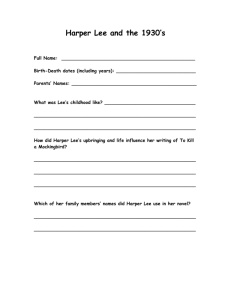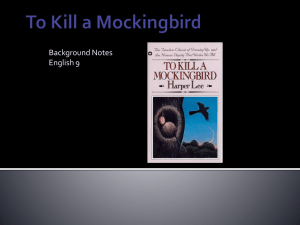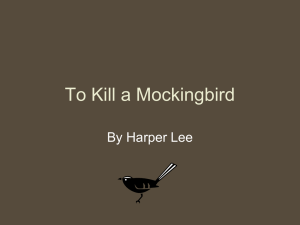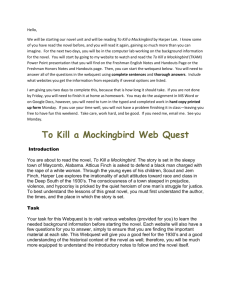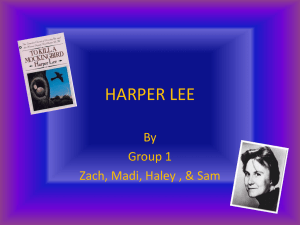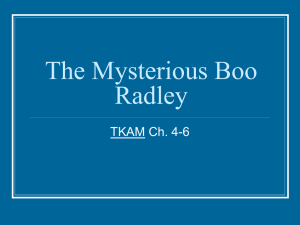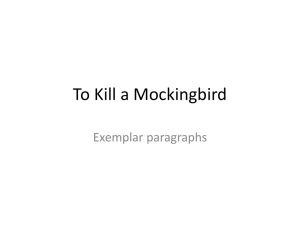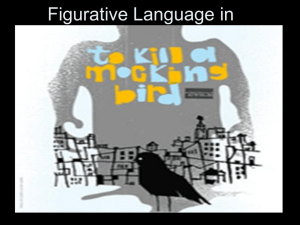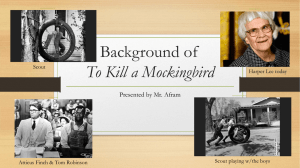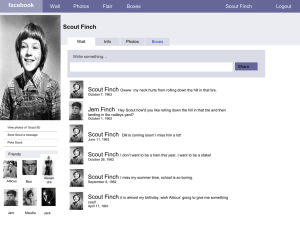File - Mr. Stamey`s 8th Grade Language Arts Class!
advertisement
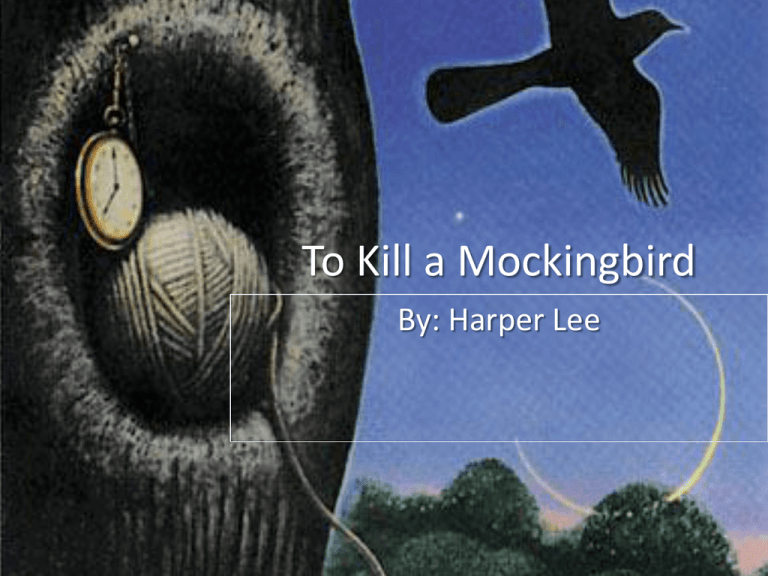
To Kill a Mockingbird By: Harper Lee OVERVIEW OF THE NOVEL • AUTHOR: Harper Lee • PUBLICATION DATE: 1960 • SETTING: Maycomb, Alabama 1933-1935 • POINT OF VIEW: First person narrative • THEMES: – Lack of need for human compassion. – Need for individual conscience. HARPER LEE (Nellie) Harper Lee BORN: April 28, 1926 PLACE OF BIRTH: Monroe, Alabama PARENTS: Amasa C. and Frances (Finch) Lee. • Related to Robert E. Lee. • • • • AWARDS • 1960 Pulitzer Prize for Distinguished Fiction by an American author • National Conference of Christian and Jews Brotherhood Award • Paperback of the Year Award • Book-of-the-Month Club EDUCATION • Monroe, Alabama Public School • Huntington College in Montgomery, Alabama (1944) • attended Oxford College one year as a Fullbright scholar AUTHOR’S LINKS TO THE NOVEL’S PLOT AND CHARACTERS • Harper Lee’s father was a Southern lawyer. He served as the prototype for Atticus Finch. • Harper Lee’s age (6 to 8) correlates with Scout’s age during 1933-1935, the time period of the book. • The courtroom in Maycomb is patterned after the one in Monroeville where Harper Lee observed her father in courtroom proceedings. • Tom Robinson’s trial appears to be a composite of many trials in the South, specifically the Scottsboro trials. • Some of the novel’s characters are composites of people Harper Lee knew personally; for example, the author Truman Capote as Dill. CHARACTERS • ATTICUS FINCH – lawyer, father of Scout and Jem; widower CHARACTERS • JEAN LOUISE “SCOUT” FINCH – adult narrator as story begins; narrates story in retrospect; relates events that begin when she is 6 years old. CHARACTERS • JEM FINCH – Scout’s brother, who is 4 years older than she. CHARACTERS • CHARLES BAKER “DILL” HARRIS – 7year-old visitor to Maycomb; acts as a catalyst MORE CHARACTERS • ARTHUR “BOO” RADLEY – neighborhood recluse MORE CHARACTERS • CALPURNIA – the black housekeeper for the Finch family MORE CHARACTERS • AUNT ALEXANDRA – Scout & Jem’s aunt MORE CHARACTERS • MAUDIE ATKINSON – friend and neighbor of Finch family MORE CHARACTERS • TOM ROBINSON – black man accused of raping a white girl MORE CHARACTERS • MAYELLA EWELL – the girl who accuses Tom of rape • BOB EWELL – Mayella’s father MORE CHARACTERS • HECK TATE – sheriff of Maycomb ATTICUS Justice JEM Innocence SCOUT DILL CALPURNIA & Helpfulness MAUDIE CHARACTERS AS SYMBOLS BOB Bigotry & Or Mayella Prejudice Ewell TOM ROBINSON Helplessness & BOO Major Historical Happenings that Impact the Novel... • Jim Crow Laws/Racial Injustice • Scottsboro Trials • Recovering from the Great Depression/Poor South • Gender Bias Jim Crow "Jim Crow" was a fixture of the minstrel shows that toured the South in which a white man, dressed up as a black man, sang and mimicked stereotypical behavior in the name of comedy. Sheet music cover illustration with caricatures of ragged AfricanAmerican musicians and dancers. 1847 Jim Crow Laws • After the American Civil War most states in the South passed anti-African American legislation. These became known as Jim Crow laws. • These laws included segregation in… – Schools -- Hospitals – Theaters -- Water fountains – Restaurants – Hotels – Public transportation – Some states forbid inter-racial marriages SAMPLE LAWS •The officer in charge shall not bury, or allow to be buried, any colored persons upon ground set apart or used for the burial of white persons. •It shall be unlawful for a negro and white person to play together or in company with each other at any game of pool or billiards. •It shall be unlawful for any amateur white baseball team to play baseball on any vacant lot or baseball diamond within two blocks of a playground devoted to the Negro race, and it shall be unlawful for any amateur colored baseball team to play baseball in any vacant lot or baseball diamond within two blocks of any playground devoted to the white race. •Books shall not be interchangeable between the white and colored schools, but shall continue to be used by the race first using them. (North Carolina) Waco, Texas 1939 Memphis, Tennessee 1943 Durham, North Carolina 1940 So, what was the punishment for breaking a Jim Crow law? Whipping Intimidation The costumes and rituals of the new Ku Klux Klan became symbols of terror in America during the first three decades of the twentieth century. (1915). The new Klan spread all over the nation with a membership numbering over three million in the 1920s. Cross Burning FICTIONAL BEGINNING • 1905 The Clansman written by Thomas Dixon – modern father of the Ku Klux Klan. • 1915 Birth of a Nation – movie based on above book. • Ku Klux Klan adopted the ritual as a means of intimidation and violence. Lynching (the illegal execution of an accused person by a mob ) These laws were instituted in 1896 and were not abolished till the late 1950’s (even then still not completely). • 9 young AfricanAmerican men (1320) accused of raping 2 white girls in 1931 • Immediately sentenced to death • Trials went on for nearly 15 years before all the men were dismissed • Started on a train bound for Memphis • Several white men boarded and picked a fight with the black men • Whites were forced off train by the 12 black men. The white men reported the black men had raped two white girls on the train to authorities • They were immediately arrested and tried in front of an all-white jury. The Great Depression 1929-1939 • Stock market crash • Didn’t realize the effect it would have • No money to replenish what was borrowed Many found being broke humiliating. Why was this bad? • Credit system – People didn’t really have the money they were spending • WWI – The U.S. was a major credit loaner to other nations in need – Many of these nations could not pay us back • Farmers were already feeling the effects – Prices of crops went down – Many farms foreclosed • People could not afford luxuries – Factories shut down – Businesses went out • Banks could not pay out money • People could not pay their taxes – Schools shut down due to lack of funds • Many families became homeless and had to live in shanties Many waited in unemployment lines hoping for a job. People in cities would wait in line for bread to bring to their family. Some families were forced to relocate because they had no money. A drought in the South lead to dust storms that destroyed crops. “The Dust Bowl” The South Was Buried • • • • • Crops turned to dust=No food to be sent out Homes buried Fields blown away South in state of emergency Dust Bowl the #1 weather crisis of the 20th century The Roaring 20’s • The new concept of “credit” • People were buying: – Automobiles – Appliances – Clothes • Fun times reigned – Dancing – Flappers – Drinking Gender Bias (Prejudice) • Women were considered “weak” • Women were generally not educated for occupations outside the home • In wealthy families, women were expected to oversee the servants and entertain guests • Men not considered capable of nurturing children QUESTIONS TO CONSIDER (Prediction) 1. What was America like during the time of this book? 2. What experiences and people did Harper Lee rely on in order to develop her plot and characters? 3. Is there still prejudice in America today? 4. **What is the significance of the title with regards to the plot and symbolism?

